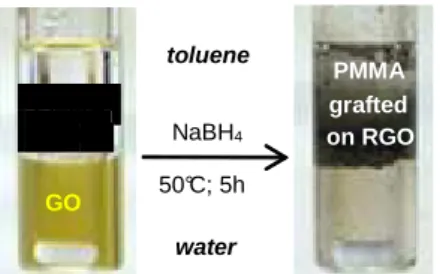An Efficient Biphasic Synthesis of Polymer-Grafted Reduced Graphite
Oxide Based Nanocomposites
Daniela Vuluga, Jean-Michel Thomassin, Isabel Molenberg, Isabelle Huynen,Christine Jérôme, Michaël Alexandre and Christophe Detrembleur
Center for Education and Research on Macromolecules (CERM), University of Liege, Sart-Tilman B6a, 4000 Liege, Belgium; E-mail: michael.alexandre@ulg.ac.be
The reduction of graphite oxide (GO) in presence of reactive poly(methyl methacrylate) (PMMA), under mild biphasic conditions, directly affords graphene grafted with PMMA. The resulting nanocomposite shows excellent electrical conductivities resulting from the optimal dispersion and exfoliation of graphene in the polymer matrix.
A powerful method to improve and/or modify the properties of polymer-based materials goes through the incorporation of high aspect ratio carbon-based nanoparticles [nanotubes (CNT), nanofibres (CNF), and nanosheets or exfoliated graphite (CNS)].[1] However, a common and fundamental problem in polymer-based nanocomposites is the large extent of agglomeration of the nanoparticles. Therefore, developing specific techniques to control deagglomeration and possibly further organization of these high aspect ratio nanoparticles in polymeric materials is a real challenge.[2] It is important to note that dispersion methods that isolate nanoparticles one from each others are not always useful for the final properties of the materials, i.e. when those properties are strongly linked to nanoparticles interconnections/interactions.
In order to control the organization of these carbon nanoparticles in polymer matrices, we have set up a “grafting to” technique that uses well-defined reactive polymers prepared by controlled radical polymerization. Thus, the reduction under mild biphasic conditions (Figure 1) of a water based dispersion of graphite oxide (GO) using NaBH4 in presence of a toluene solution of
reactive PMMA end-capped by a clivable alkoxyamine (PMMA-ONR2) easily prepared by in situ Nitroxide Mediated Polymerization, directly affords graphene grafted with PMMA. The resulting nanocomposite shows excellent electrical conductivities resulting from the optimal dispersion and exfoliation of graphene in the polymer matrix.
Figure 1 Biphasic one-step GO reduction/PMMA-ONR2 grafting reaction
Key Words: graphene, nanocomposites, grafting onto, NMP
References:
1. Spitalsky, Z., Tasis, D., Papagelis, K., Galiotis, C. Prog. Polym. Sci. 2010, 35, 357-401. 2. Compton, O. C., Nguyen, S. B. T. Small 2010, 6, 711-723.
PMMA -ONR2 GO PMMA grafted on RGO water NaBH4 50 °C; 5h toluene
